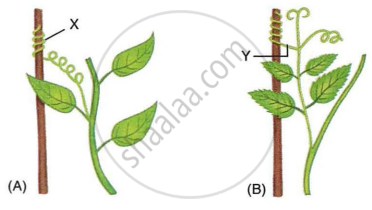Advertisements
Advertisements
प्रश्न
The leaves of the 'chhui-mui' plant begin to fold up and droop in response to a stimulus. Name the stimulus and write the cause for such a rapid movement. Is there any growth involved in the movement?
उत्तर
The leaves of the 'chhui-mui' plant, also known as the 'sensitive' or 'touch-me-not' plant of the Mimosa family, begin to fold up and droop in response to touch.
This movement is an immediate response to the stimulus of touch and does not involve growth. Unlike animals, plants lack nervous and muscle tissue, so they rely on electrical-chemical means to convey information from cell to cell.
In response to touch, certain plant cells change shape by altering the amount of water within them, resulting in swelling or shrinking. This change in cell shape leads to the rapid movement of the plant's leaves folding and drooping.
Thus, the stimulus is touch, and the cause of the rapid movement is the electrical-chemical communication between cells leading to changes in cell shape, without any growth involved in this movement.
APPEARS IN
संबंधित प्रश्न
What happens to the moonflower
- during the daytime, and
- at night?
What is this phenomenon known as?
What is a tendril?
Plant shoot grows upward in response to ______.
Define phototropism. Give one example of phototropism.
Define thigmotropism. Give one example of thigmotropism.
Dandelion flowers open the petals in bright light during the daytime but close the petals in dark at night. This response of dandelion flowers to light is called:
The plant part which exhibits negative geotropism is ______.
Thigmonasty can be seen in ______.
Analogy:
Hydrotropism: Response towards water:: Phototropism: ______.
Study the diagrams given below and answer the following questions:

- Name the structures shown as X and Y in the figures (A) and (B), respectively.
- Write the functions performed by the structures X and Y.
- Name the phenomenon depicted and define it.
- How do the structures X and Y differ from each other?
- Give examples of the plants which show the said phenomenon.
